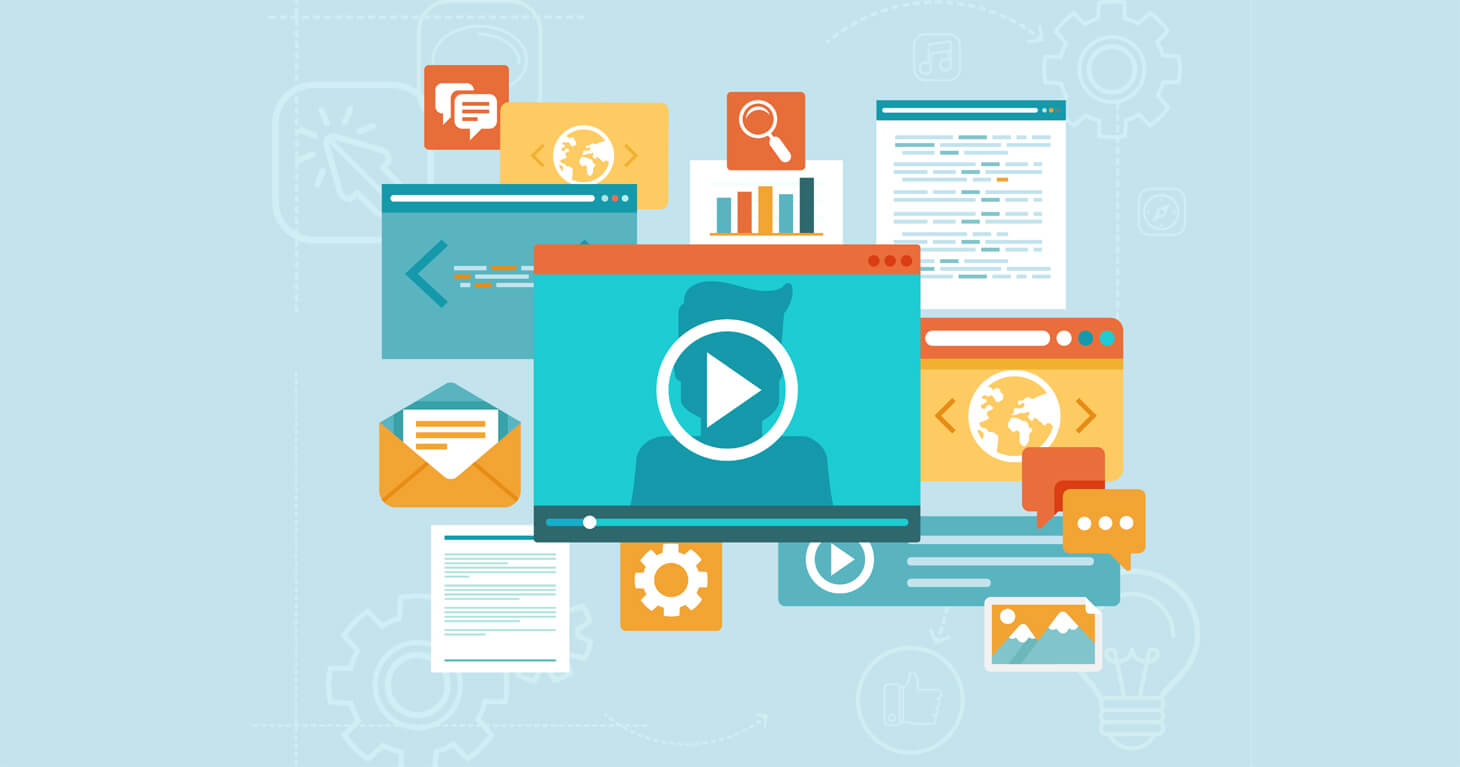What is a webinar?
A webinar is an online event held in the form of a seminar or conference in which hundreds of people located in different countries can participate through the Internet. For such an event you can use a variety of platforms, such as YouTube, Google Hangouts, GetResponse and others.
Typically, a webinar features the following participants:
- Organizer;
- Speakers;
- Listeners.
Everything is the same as in an offline event, but it all takes place online. The organizer manages the process, the speakers present, and the listeners attend and watch the webinar presentation on the screen or listen to the audio. Sometimes speakers also broadcast their video, which is optional.
Typically, an entry and spread of the presentation are sent to participants after the webinar.
When is a webinar an excellent solution?
If you must convey information simultaneously to a large number of users in different places, the webinar is your choice. This is a cost-effective solution through which you can not only reach out to hundreds of people, but also publicize your products. For example, in the travel niche you can create webinars on such topics as:
- How to travel cheaply;
- How to organize a trip yourself;
- 10 ideas on where to go for vacation;
- Where to go for vacations with children;
- And others.
You are limited only by your imagination. An online event gives your audience the opportunity to learn something new without spending a lot of time, energy and money. To attend an offline conference, they have to travel somewhere, book a hotel, spend time on the road and waste a lot of money. Of course, many people may not visit you offline. Webinars allow all participants to maintain flexibility; this is why a webinar is a very popular and efficient means of sharing information with your audience.
How to host a webinar: Best practices
To help you create an excellent webinar, we interviewed Olga Gachkova, Marketing Manager at Travelpayouts, and collected 10+ webinars best practices, which will be useful for beginners, as well as those who have already created a couple of online events.
Define your webinar purpose
First and foremost, define the goal of your webinar and then think whether it’s the best way to reach it. Webinars are a time-consuming and resource-intensive tool, so make sure that you really need it.
Here are a few examples of goals a webinar can help achieve:
- Generate leads
- Sell or promote a product
- Educate your audience
- Promote your services
- Build trust
The latest goal is no less important than the others. You will be able to make sales only if customers trust you and see you as an expert. The world of affiliate marketing is not always transparent to people from the outside, so organizing an online meetup can greatly help inspire confidence.
After defining the purpose, you can now proceed to the technical side, namely, choose your webinar format and prepare content.
Always know your audience!
Knowing your audience is the foundation. You must start at this point because without understanding your audience’s desires and needs, it is hard to hit the mark.
To better understand the situation, answer these three fundamental questions:
- Who will attend – gender, age, language, etc.?
- What problems do these people have?
- What goals can they pursue in my webinar?
Address these questions and your event will be of high value.
The topic of the presentation
The second step is to choose the topic of the presentation. Usually, people attend a webinar to learn something new or find answers to their questions. Your goal is to give people what they want.
For example, if your audience consists of young parents, they will be interested in the topic of traveling with kids. In that case, it would not make sense to create a seminar about extreme travel. Therefore, the second step follows from the first – understand who your listeners are, then find a topic that will interest them.
If you have trouble coming up with a topic, we have collected some tips for choosing one:
- Remember which questions your visitors are asking you;
- Look at Google Analytics or Google Trends to see what is trendy on the Internet or on your website;
- Ask your audience which topic they want to learn about or discuss. Do this on social media because it is more convenient to share ideas there.
- Get ideas from your competitors; just make sure you do it better than they do
Don’t choose a topic that is too broad, as it will be hard to find an audience that is interested in it. Select a narrow, specific topic and find its target audience. If you do this, people will be interested in attending and will stay from the beginning until the end, which means you will get better results.
Find a good speaker
People learn better from someone whom they perceive is an authority. The speaker is a source of information for them – a mentor or teacher. The best speaker:
- Is an expert in the subject;
- Has good speaking skills;
- Evokes a feeling of trust and authority.
If you have attended webinars in the past, you probably know that the audience’s impression of the webinar is based on its speaker. This is why it is important to find a good one.
You can invite an industry expert or professional speaker, or deliver a speech yourself. Do not choose someone simply because he or she has the best speaking skills, as such skills are worthless if the person is not well-versed in the subject. Strike a balance among all components.
Find the best date and time
While online events are generally convenient, your choice of time will affect the number of people who attend. Therefore, choose the time wisely.
- Different countries have different time zones. Choose a time so that most of your listeners will be participating between 9 am and 6 pm.
- Your choice of a workday, weekend or holiday can influence attendance.
- Announce the webinar at least 3 weeks before its date
- After the webinar, solicit feedback about the date/time from listeners.
Keep in mind that finding the perfect time is impossible. There will always be people who can’t attend. This is normal. Focus on the majority.
Choose the right webinar platform
To broadcast live, you must join a webinar platform. Complete this step in advance, as the next step – promotion – is impossible without it.
To broadcast live, you must join a webinar platform. Complete this step in advance, as the next step – promotion – is impossible without it.
There are basically two ways to hold a webinar:
- On a dedicated platform like GetResponce. This is a popular platform with an easy interface which allows you to create a webinar and landing page, get your audience to sign up for the event and then send emails to subscribers. Other such platforms include Adobe Connect, Google Hangouts, ON24, Webex, and more.
- In social media, for example, through Youtube or on Facebook. Youtube is beneficial in many ways, as it provides additional promotion options. Thus, if your webinar is successful, and viewers are not leaving, the platform will suggest other users to join it as well. Moreover, YouTube saves webinar video right after the broadcast, so users can put it on pause and finish watching whenever they find it convenient.
The choice of a platform should depend on your goals. Travelpayouts uses both methods for setting up a webinar meeting, but lately has been broadcasting on social media. To capture new leads, we usually create a landing page where users can sign up and then get a link for the broadcast. Thus, we need to not only grow the email base, but also evaluate the performance afterwards. It usually takes about five weeks to prepare such an event and not knowing whether it’s been useful in bringing new leads makes little sense.
Define your purposes and choose the platform that is the best fit for you. Look at the features that are available to speakers and listeners. Also keep in mind the limits. Usually the fees are based on the number of people who can simultaneously connect to your event. One of the worst things that can happen is that you reach your limit during the event and those who wish to connect cannot do so. For example, if you had space for 1,000 people, but in reality 1,200 tried to attend, that means 200 people were turned away. Make sure you avoid such a situation. The attendance rate among those who subscribe is usually 30-40%.
Do not forget about mobile users
As we already wrote in an article about the mobile version of your website, in some countries over half of people access the Internet using only their phones. Therefore, do not forget about mobile users who will access your webinar. This advice is valid for everything: the landing page, the webinar itself and any other elements with which your audience interacts.
Promote your future webinar
The first step was preparation, but this will be incomplete without promotion. Preparing a webinar would do no good if no one found out about it? Use all the promotional tools you have; for example:
- Create a landing page;
- Write a post on your website;
- Write an announcement on your social networks;
- Send emails to your subscribers;
- Buy advertisements on Google or Facebook.
A landing page is a web page where visitors will go to learn about your event. You can create a simple post in a blog, but it’s better to set up an independent page that is dedicated to the webinar, for example:
On the landing page, you’ll provide the most important information about the event:
- The topic;
- The day and time;
- Information about the speakers;
- A more detailed webinar plan.
Of course, you should convert your landing page visitors into participants. To do that, embed a subscription form where the visitor can leave his or her email address; this way, you can regularly remind visitors about the upcoming event. Also make sure to not use unnecessary elements, as the page should serve one objective–get people to sign up and not leave it through other links. You can create a landing page on your website or use dedicated platforms such as Webinars, GetResponse, and so on.
Social media can also be a great way to reach more people. For instance, publish a post about the upcoming webinar on your page, in related groups as well as on your speakers’ pages. Their audiences can be your audiences too. Contextual advertising is beneficial for a regular webinar, for example, if you plan to run webinars regularly or promote a major event.
It’s a good idea to start promoting the webinar as soon as you choose the topic, the structure and the day on which you will hold it. You can develop the speech and presentation while you work on advertising.
After the registration, the user should get a confirmation letter. Otherwise, people might be unsure whether they managed to sign up or not.
Prepare your speech and presentation
Whether this is your first or hundredth webinar, you must prepare for it. Create a plan for your webinar. Then create a script for your speech and prepare the presentation.
Based on your goal, audience, and promotional channels, put together your content. It’s very important to understand that people rarely watch webinars the whole time without distraction. Instead, they are likely to listen to it while doing something else, so try to make your webinar interactive to hold the attention longer.
Prepare a presentation that will represent and explain the topic. It should not repeat your speech word by word, but disclose even more about the topic or show something that cannot be told in words. Your speech involves sound perception, while the presentation is visual. People will first look at your slides and only then listen to the speaker, consuming over two thirds of information through a visual channel. So take advantage of this fact and make a presentation that will capture their attention and prevent them from leaving the webinar.
Also take into account that slides should be understandable even without the audio recording, as some people might skip the webinar but look through slides. On the other hand, images are more efficient than words to send the information, so try to find the right balance between text and graphics. The more diverse, colorful, and fun your presentation, the more likely you are to hold the attention of the audience.
At the same time, it’s also important to show speakers throughout the webinars to create a feeling of live communication, because people react differently when they see a person talking rather than just pictures. So even when you show a presentation, make sure to put the speaker’s video too.
The main reason why people come to a webinar is to see a live demonstration. So, make sure to broadcast speakers’ videos throughout the whole webinar, as listeners will feel they take part in a live communication rather than just watch slides. However, do not include too much content in the event. It’s hard to focus for over 40 minutes, so try to keep the webinar within this time frame.
The script is your assistant, but don’t read it all; just follow your own plan and speak freely. The speaker’s voice should contain as few parasite words as possible. The tone of your voice should be understandable; convey the sense that you understand the topic and are happy to share your knowledge. Don’t be too fast or too slow while speaking; find a balance.
Apart from your tone of voice and speed of speaking, you can prepare jokes to ensure your webinar isn’t boring. A good sense of humour can attract the audience’s attention. Also be sure to look at the camera sometimes while you’re talking. Many people are not able to look at the camera because they are shy or anxious. However, for effective communication, eye contact – looking at the camera – is important.
Make sure to run a couple of test sessions in advance to check whether everything is in place. Speakers must have a non disturbing background and know how to use the webinar platform. Thus, they’ll feel more confident on the day of the webinar. Sound quality is more important than video, because people might not watch it but they’ll for sure listen to it, so also make sure all speakers have proper microphones.
When everything is ready, rehearse. If possible, have someone listen to you and provide feedback. Or, you can record your rehearsals and watch them to learn how you can improve.
Remind your subscribers about the webinar
Your promotion will not be effective if you do not remind subscribers about the event. Elizaveta Rudykh from the Travelpayouts team recommends creating the following correspondence:
- Confirmation letter;
- 1-day reminder;
- 1-hour reminder;
- Follow-up email.
All these emails are also ways to promote additional content for a highly interested audience. Therefore, add content using the statement “You might also be interested in”.
On your landing page, you can offer choices to the audience:
- To attend the webinar;
- If they cannot attend, to receive slides and recordings.
If you have these options, send a reminder about the beginning of the webinar only to those who registered for the webinar; then send a recording after the webinar to those who requested one. Also send a recording to those who attended the webinar.
How to run a webinar and the most common mistakes
Following our instructions, you will avoid most of the common mistakes.
Don’t skip the introduction. It usually takes five to ten minutes at the very start of the webinar and gives listeners the context–topic, agenda, speakers, rules, and so on. You can also use this time to boost the activity in the chat, asking whether people can hear you well, where they are from, and so on. And there are always latecomers, so the introduction gives them a chance to not miss any important content.
Don’t be nervous and don’t panic during the event. The audience will feel it and their experience could suffer. It can be difficult to relax, but remember a simple thing – just one person is in front of the computer. Even if 1,000+ listeners are on your webinar, they are not sitting together. Imagine that you are delivering your speech to one person, like on Skype or Whatsapp.
Of course, do not be afraid of making a mistake. We are all human, and mistakes happen. You can always joke about any unexpected problems. Expected issues should be resolved in advance to prevent them from occurring during your presentation.
Be very careful about your Internet connection and surrounding noises. Mute all apps and devices and close the windows in the room. Switch off all Internet users except for the webinar platform.
During the webinar, remember its purpose – for example, to generate traffic for your flight tickets website so that you can earn with Travelpayouts, or to sell your services or goods. Also think about the listeners – they have come to learn something, so teach them.
Start on time. If you wrote that the event starts at 2 pm, that’s when it should start, even if not every attendee has joined. To avoid problems, during the first 3-5 minutes – when most of the attendants will join – you can speak about organizational matters, then start on the main issue.
Stick to the time limit. It’s hard to hold the audience’s attention for long, so try to limit your content part of the webinar by 40-45 minutes, aside from the introduction and the Q&A part.
After your speech, give people the option to ask you questions. A Q&A is a tool for both sides; you and the listeners can learn more. Attendees get answers to their questions, while you can learn more about the interests of your audience. Moreover, you can collect feedback from your listeners to make your next webinar even better. Prepare a fake question in advance; if your audience is not active, this will help warm them up and get questions from real people.
At the very end, make sure to thank your audience for their attention and questions. Also, explain what will happen next, for example, whether you’ll send them the recording and slides, and so on.
Evaluate your webinar efficiency
It’s now time to assess the results and send the recording and slides to the audience.
How can you measure the outcome? It all depends on your webinar goals. Thus, if the original purpose was to make sales, check the number of purchases of the product that you’ve promoted. For a webinar aimed at generating leads, look at the number of signups, and so on.
Performance indicators will also point to problems, for example, if a big part of listeners left at the same moment, there must have been an issue–a technical error, irrelevant content, etc. So next time, you might want to use another platform, reach to a different audience, and so on.
Summary
A webinar is a powerful tool for staying in touch with your audience. At the same time, it is a convenient way to share information and, for listeners, to learn something new. Don’t skip this amazing tool for earning in the travel niche. A webinar can surprise you with its sales conversion rate.
Creating a webinar is not an easy task. We hope that our ultimate guide will allow you to plan a webinar with high value for attendants. Don’t forget about monetizing the event. It is better to consider this during the first stage, while you are researching your audience.




